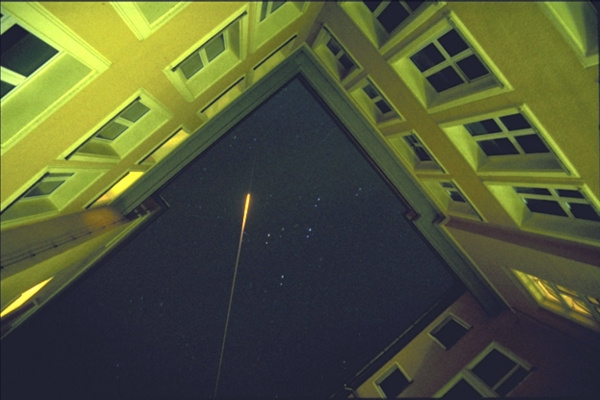
TERAMOBILE and large laser facilities
The former group of prof. J.-P. Wolf in Lyon (link) has performed the pioneering work demonstrating the feasibility oflong range detection (50 m) of biological aerosols in the atmosphere,using ultrashort Terawatt (TW) pulses (G. Méjean et al, Applied Physics B 78(5), 535-537 (2004)). This study was carried out with the TERAMOBILE, the first femtosecond TW laser in the world. The TERAMOBILE project was started in 1999 by a consortium of 4 European institutions(Universities of Jena (link) and Berlin (link) in Germany, University of Lyon (link) and Ecole Polytechnique (link) in France) to use the non-linear propagation of ultrashort lasers for atmospheric applications (J. Kasparian et al, Science 301(5629), 61-64 (2003)).
As TW pulses propagate in the atmosphere, a series of non-linear induced effects (Kerr self-focusing, higher-order Kerr defocusing, multiphotonionization, etc.) generate “light filaments” in air (L. Bergé et al, Phys. Rev. Lett. 92(22) 225002 (2004)). These filaments are characterized by an exceptionallybroad white light continuum (ranging from 230 nm in the ultraviolet, tomore than 4.5 µm in the mid-infrared) covering absorption bands of manyatmospheric pollutants and trace gases. They can therefore be exploitedas a “white laser” for remote sensing of the constituents of atmosphere, including pollution gases and aerosols.
Moreover, the TERAMOBILE team has demonstrated that high voltage (MV) electric discharges can be triggered and driven over up to 10 m distance by the filament, whichcreates a weakly conducting plasma channel in the atmosphere (R.Ackermann et al, Appl. Phys. Lett. 85(23)5781-5783 (2004)). We recently showed that the plasma channel can becontrolled by the use of a closed-loop algorithm and then created at aspecific location (R. Ackermann et al, Appl. Phys. Lett. 89, 171117 (2006)). This study opens unique perspectives for the control of lightning.
Furthermore, in collaboration with the Forschungszentrum Dersden-Rossendorf (link), we showed that a 100 TW beam generates multiple filaments, although the filament number is limited by the beam diameter. Consequently, non-linear processes initiate in the photon bath surrounding thefilaments (Y. Petit et al., Physical Review A, 83, 013805 (2011)), which drastically increases the total yield of laser-induced condensation (M. Petrarca et al., Applied Physics Letters, 99, 141103-141103-3 (2011))
